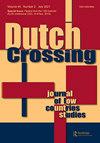Conversion and Missionary Narratives in Post-Independence Congo. A Comparative Analysis of Jacques Bergeyck’s Het stigma/The Stigma (1970) and V.Y. Mudimbe’s Entre Les eaux/Between Tides (1973)
IF 0.4
3区 历史学
Q1 HISTORY
Dutch Crossing-Journal of Low Countries Studies
Pub Date : 2023-01-02
DOI:10.1080/03096564.2022.2144591
引用次数: 0
Abstract
ABSTRACT Missionaries played a central role in the colonial system in Congo – they were a key part of the well-known triad consisting of state, church, and corporations. During the Belgian Congo period (1908–1960), missionaries of diverse congregations were in charge of health care and education, and their religious services were the only ones officially recognized. Narratives have strongly shaped how these missionaries operated. One could even say that the conversion and missionary narrative define what it means to set up a successful ‘mission’. In my contribution, I explore how these narratives surface in two novels written in the two decades after Congo’s Independence in 1960. Entre les eaux (1973) by V.Y. Mudimbe and Het stigma (1970) by Jacques Bergeyck both refer to the missionary activities in mid-century Congo but their use of the conversion and missionary narrative complicates the common-sense understanding of them. By comparing a Flemish and a Congolese novel, this article aims to decentre the Flemish literary world as the locus where these narratives gain their meaning. By taking a more transnational, multilingual context as a starting point, it wants to shed new light on the ways in which the European missionary presence in Congo has been imagined.独立后刚果的皈依与传教叙事。雅克·伯格的《耻辱》(1970)与V.Y.穆丁比的《潮汐之间》(1973)比较分析
传教士在刚果的殖民体系中扮演着核心角色——他们是众所周知的由国家、教会和企业组成的三位一体的关键部分。在比属刚果时期(1908-1960年),不同教会的传教士负责保健和教育,他们的宗教服务是唯一得到官方承认的。叙事强烈地塑造了这些传教士的运作方式。人们甚至可以说,皈依和传教的叙述定义了什么是成功的“使命”。在我的文章中,我探讨了这些叙事是如何在1960年刚果独立后的二十年里写的两部小说中出现的。V.Y. Mudimbe的《Entre les eaux》(1973)和Jacques Bergeyck的《Het stigma》(1970)都提到了世纪中期刚果的传教活动,但它们对皈依和传教叙事的使用使对它们的常识理解变得复杂。通过比较一部佛兰德语小说和一部刚果语小说,本文旨在将佛兰德语文学世界作为这些叙事获得意义的场所。本书以一个更跨国、多语言的背景为出发点,希望揭示欧洲传教士在刚果的存在方式。
本文章由计算机程序翻译,如有差异,请以英文原文为准。
求助全文
约1分钟内获得全文
求助全文

 求助内容:
求助内容: 应助结果提醒方式:
应助结果提醒方式:


